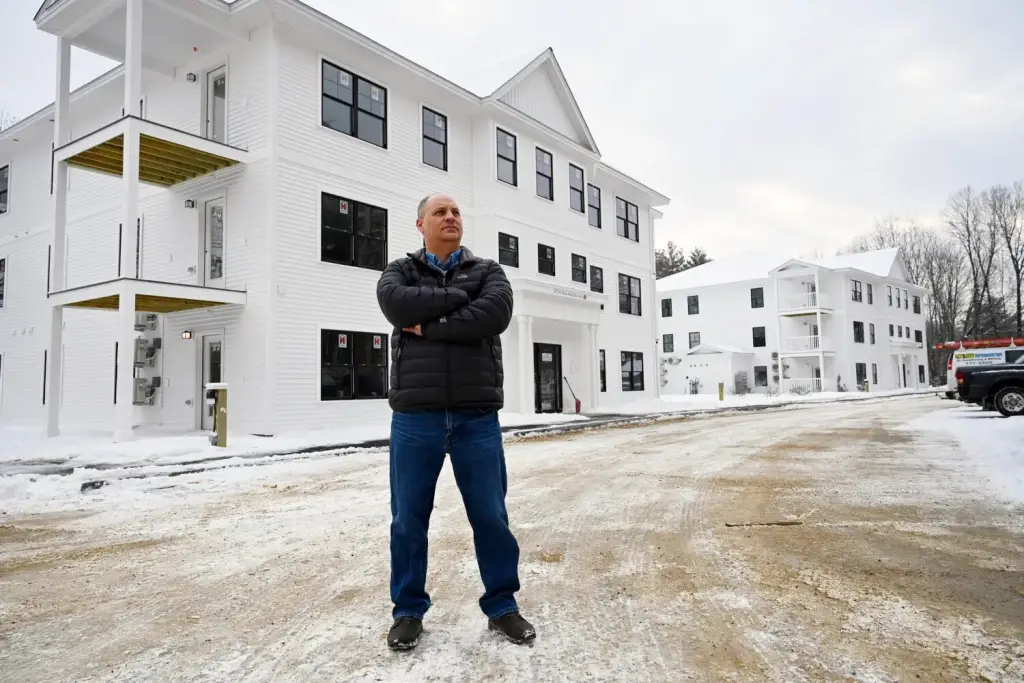Sam Hight only had to pay the town of Madison $1 for a prime piece of land. That low cost made it possible for Hight and his partners to build an 18-unit affordable housing complex that opened last year. However, the project could not have moved forward without a state subsidy, even though the developers had the most cost-effective construction plan available for a project of this size.
Hight has been searching for ways to develop market-rate housing using conventional financing. However, with high costs for multi-unit buildings, rising interest rates, and expensive construction materials, he found it nearly impossible to make the numbers work. Hight, who runs his family’s car dealerships in Skowhegan, is not alone in this struggle.
Many developers working on market-rate housing in low-income areas of Maine face the same problem. The state has ambitious housing goals that rely on rural communities increasing their housing production. But without subsidies, developers cannot keep units affordable, making it unlikely that affordable housing will be built without government assistance.
The Madison project cost $5 million to complete. Of that amount, $3 million came from a 45-year loan through a rural housing program managed by MaineHousing. While the actual cost per unit was around $280,000, the subsidy lowered it to just over $110,000. This reduction made it possible to meet affordability requirements, which mandate that the apartments remain accessible to people earning no more than 80% of the area’s median income.
To keep costs low, Hight and his partners used modular homes from KBS Inc. of South Paris. They also avoided additional expenses by not needing to construct roads or pay for utility hookups. This spring, they plan to start a similar 18-unit modular housing project in Rumford, a western Maine town where the median household income is about $40,000, according to Census data.
Kara Wilbur, a developer working with Hight through modular builder Dooryard, emphasized that they are using the most affordable construction methods available. In Rumford, they purchased land for $12,000, significantly below its $46,000 valuation. The town of Rumford has recently made efforts to attract affordable housing developers by offering such land discounts.
Low-cost or even free land is often a crucial factor in making projects financially viable. Developer Kevin Bunker, principal at Portland-based Developers Collaborative, has leveraged similar deals in cities such as Bangor, Portland, and Augusta. These discounts can also help projects rank higher in Maine housing subsidy applications, increasing their chances of receiving financial support.

However, offering cheap land is not a perfect solution. Rumford’s town manager, George O’Keefe, remains cautious about giving away land, as he wants to protect property values. Additionally, high construction costs and interest rates mean that even free land does not significantly reduce overall project expenses.
Bunker noted that while land may account for about 10% of a total project’s cost, construction makes up around 80%. Even if the land cost were reduced to zero, it would not have as much impact as a significant drop in construction costs.
The funding program that Hight and Wilbur rely on does not have a permanent source of funding from the state. Lawmakers are currently discussing this issue. House Speaker Ryan Fecteau has proposed a bill that would ask Maine voters to approve a $300 million housing bond, including $25 million specifically for the rural rental program.
However, Hight pointed out that even with such a large sum, the amount is still not enough to meet housing needs across the state. In the long run, policymakers will need to address the regulatory and code restrictions that make housing development more difficult at the municipal level. If these barriers remain in place, developers will have no choice but to wait for interest rates and construction costs to decrease before moving forward with new projects.
Hight and his partners aim to create a sustainable housing model that does not rely on government subsidies. However, without major changes in regulations or financial conditions, developing affordable multi-unit housing in rural Maine remains a difficult challenge.
Disclaimer: This article has been meticulously fact-checked by our team to ensure accuracy and uphold transparency. We strive to deliver trustworthy and dependable content to our readers.




